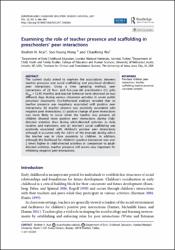| dc.contributor.author | Acar, İbrahim Hakkı | |
| dc.contributor.author | Hong, Soo-Young | |
| dc.contributor.author | Wu, ChaoRong | |
| dc.date.accessioned | 10.07.201910:49:13 | |
| dc.date.accessioned | 2019-07-10T19:52:22Z | |
| dc.date.available | 10.07.201910:49:13 | |
| dc.date.available | 2019-07-10T19:52:22Z | |
| dc.date.issued | 2017 | en_US |
| dc.identifier.citation | Acar, İ. H., Hong, S. Y. ve Wu, S. (2017). Examining the role of teacher presence and scaffolding in preschoolers' peer interactions. European Early Childhood Education Research Journal, 25(6), 866-884. https://dx.doi.org/10.1080/1350293X.2017.1380884 | en_US |
| dc.identifier.issn | 1350-293X | |
| dc.identifier.issn | 1752-1807 | |
| dc.identifier.uri | https://dx.doi.org/10.1080/1350293X.2017.1380884 | |
| dc.identifier.uri | https://hdl.handle.net/20.500.12511/2388 | |
| dc.description | WOS: 000416559800006 | en_US |
| dc.description.abstract | The current study aimed to examine the associations between teacher presence and social scaffolding and preschool children's peer interactions. Using a time sampling method, peer interactions of 22 four-and five-year-old preschoolers (12 girls; M-age = 52.95 months) and teacher behavior were observed on two different days during various classroom activities in seven public preschool classrooms. Eco-behavioral analyses revealed that (a) teacher presence was negatively associated with positive peer interactions; (b) teacher absence was positively associated with negative peer interactions; (c) positive change of peer interactions was more likely to occur when the teacher was present; (d) children showed more positive peer interactions during child-directed activities than during adult-directed activities or daily routines and transitions; and (e) teacher's social scaffolding was positively associated with children's positive peer interactions although it occurred only for 3.61% of the intervals during which the teacher was in close proximity to children. In addition, although the likelihood for children's positive interaction was over 2 times higher in child-directed activities in comparison to adult-directed activities, teacher presence still seems very important for inhibiting negative peer interactions. | en_US |
| dc.language.iso | eng | en_US |
| dc.publisher | Routledge Journals, Taylor & Francis Ltd | en_US |
| dc.rights | info:eu-repo/semantics/openAccess | en_US |
| dc.subject | Preschool Children | en_US |
| dc.subject | Peer Interactions | en_US |
| dc.subject | Teacher Scaffolding | en_US |
| dc.subject | Teacher Presence | en_US |
| dc.subject | Classroom Contexts | en_US |
| dc.title | Examining the role of teacher presence and scaffolding in preschoolers' peer interactions | en_US |
| dc.type | article | en_US |
| dc.relation.ispartof | European Early Childhood Education Research Journal | en_US |
| dc.department | İstanbul Medipol Üniversitesi, Eğitim Fakültesi, Temel Eğitim | en_US |
| dc.authorid | 0000-0003-4007-5691 | en_US |
| dc.identifier.volume | 25 | en_US |
| dc.identifier.issue | 6 | en_US |
| dc.identifier.startpage | 866 | en_US |
| dc.identifier.endpage | 884 | en_US |
| dc.relation.publicationcategory | Makale - Uluslararası Hakemli Dergi - Kurum Öğretim Elemanı | en_US |
| dc.identifier.doi | 10.1080/1350293X.2017.1380884 | en_US |
| dc.identifier.wosquality | Q4 | en_US |
| dc.identifier.scopusquality | Q2 | en_US |


















